-
Paper Information
- Paper Submission
-
Journal Information
- About This Journal
- Editorial Board
- Current Issue
- Archive
- Author Guidelines
- Contact Us
American Journal of Sociological Research
p-ISSN: 2166-5443 e-ISSN: 2166-5451
2016; 6(5): 126-134
doi:10.5923/j.sociology.20160605.02

Sense of Community in Gated Communities in Doha: The Case of Al-Ein Compound in Ein Khaled Neighborhood
El-Shaimaa El-Ekhteyar , Raffaello Furlan
College of Engineering, Department of Architecture and Urban Planning, Qatar University, State of Qatar
Correspondence to: Raffaello Furlan , College of Engineering, Department of Architecture and Urban Planning, Qatar University, State of Qatar.
| Email: |  |
Copyright © 2016 Scientific & Academic Publishing. All Rights Reserved.
This work is licensed under the Creative Commons Attribution International License (CC BY).
http://creativecommons.org/licenses/by/4.0/

Neighborhoods are designed to contribute towards establishing and maintaining community bonds. Gated communities, a recognizable form of housing developments in the Gulf Region, have an impact on neighborhoods and cities’ livability-namely on the quality of life of residents. In the city of Doha, gated communities are widely diffused and considered as one of the most common types of housing, which greatly influence residents’ social interactions. This research study aims to investigate the sense of community in Al-Ein compound in Ein Khaled neighborhood. Oral and Visual data was collected through (A) in-depth interviews with residents and (B) site visits, observation and photographs of the compound’s physical settings. The findings reveal that the sense of community measured in Al-Ein compound is high due to the robust community’s ties and connections among residents. Also, the findings provide guidelines to policy makers, urban planners and designers for the implementation of residential compounds’ settings in Doha.
Keywords: Gated Communities, Sense of Community, Residential Compound, Social Interactions, Doha
Cite this paper: El-Shaimaa El-Ekhteyar , Raffaello Furlan , Sense of Community in Gated Communities in Doha: The Case of Al-Ein Compound in Ein Khaled Neighborhood, American Journal of Sociological Research, Vol. 6 No. 5, 2016, pp. 126-134. doi: 10.5923/j.sociology.20160605.02.
Article Outline
1. Introduction
- The concept of gated communities is not a contemporary invention in urban design. Walled cities existed throughout history, serving purposes of security, safety and prevention of easy access to the city. Modern walled communities remerged in the 1980s in several world-wide cities as forms of residential accommodation. Since 1990s, the process of segregating population within individual communities has drastically accelerated due to the immense increase in the social and economic differences. As a result, nowadays, gated compounds are a world widely common form of residential community, namely in large cities (Furlan and Petruccioli 2016; Remali, Salama et al. 2016). Atkinson and Flint (2004) indicate that in recent years there has been a significant interest in privatized public spaces in the form of ‘gated communities’ or ‘fortified enclaves’. As a common urban typology, gated communities have significant influence on the urban form and function of cities and neighborhoods, as well as people activities and way of life. Ajibola et al (2010) suggested that spatial fragmentation and separation in cities is an expected result of the security and financial implications of gated communities. Gated communities offer social exclusion, safety, security and sense of community by their surrounding walls, which lead to urban fragmentation and separation. Gated communities in the Gulf region are one of the most common and recognizable forms of housing developments. Qatar is one of the safest counties in the world according to the new international index that assessed 70 nations based on factors such as unemployment, crime levels, and being at risk for global attacks (Salama and Wiedman 2013; Wiedmann, Salama et al. 2014). However, in Doha, this housing typology is quite dominating in the city (figure 1-2). Gated communities, commonly built by private developers, host governmental and private companies’ employees. According to census 2012, the city of Doha encloses more than 120 gated communities. In addition, several residential compounds are under construction. This is due to the rapid development that Qatar has witnessed during the last 20 years, which has severely changed the demographics, economics and lifestyle and social life in Qatar (Fromherz 2012; Furlan and Faggion 2015; Furlan and Almohannadi 2016; Furlan and Zaina 2016). The increasing percentage of expats in Doha has led to a diverse and fragmented demography in the city (Rizzo 2014; Kovessy 2015). Therefore, gated communities have become popular dominant housing form in Qatar: residents in Qatar prefer gated communities because of the provided private, pleasant and safe environment.
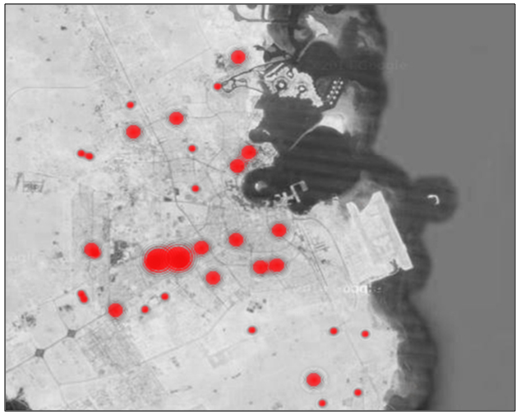 | Figure 1. Distribution of gated communities in Qatar (Qatar map, 2012) |
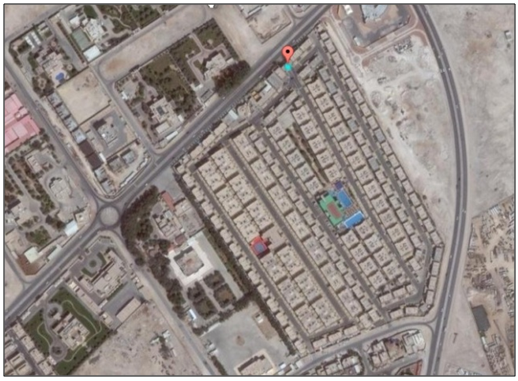 | Figure 2. Map of Al-Ein compound in Ein Khaled neighborhood (Google Earth) |
 | Figure 3. Ain Khalid’s Main Gate |
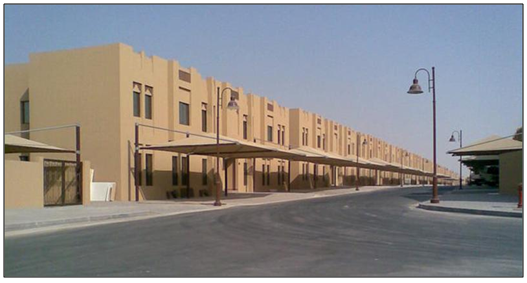 | Figure 4. Ain Khalid’s housing facing the main road |
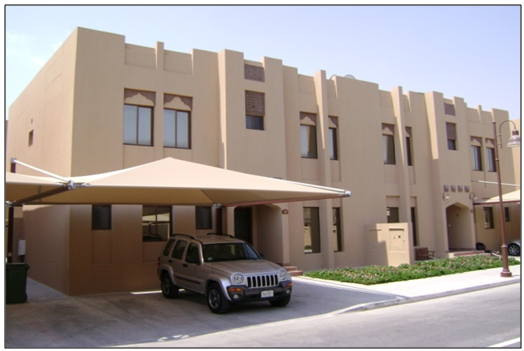 | Figure 5. Ain Khalid’s housing on the main road |
 | Figure 6. Ain Khalid’s open space |
2. Literature Review
- Sense of CommunityScholars refer to sense of community as one of the indicators of the quality of life in social classes. It can be identified as the first simplest gathering beyond the family, which is conscious of local unity and has social significance (Ashok Kumar 1973; Fried 1984; Blanchard 2008). A sense of community is related to the binder given by the members of the society to others in the community, which tolerates significance on sense of safety and belonging (Rogers and Sukolratanametee 2009). The sense of community represents an essential factor in a neighborhood, which contribute to enhance the sense of security and reduce crime opportunities within the community (Austin, Furr et al. 2002). The environmental factor is one of the fundamental factors that influences and motivate the community’s relationships (Talen 1999). Uzzell, Pol and Badenas (2002) reveal that social and the physical environment’s components can strengthen the relationships among the residents who use the community spaces in two Guildford neighbourhoods. Through their studies, Uzzell et al (2002) reveal that more than 70% of the respondents preferred the Onslow to the Stoughton neighborhood, namely in terms of physical image. Rogers and Sukolratanametee (2009) argue that the sense of community would be enhanced by an attractive physical environment since the spaces provided and created in the neighborhood would maintain and improve the social integration. McMillan and George (1986) define these spaces as well-defined boundaries that enable good community interaction and networking. Residential areas with ecological designs are found to have a higher sense of community, as found in previous researches developed at four suburban-metropolitan neighbourhoods in Houston (Rogers and Sukolratanametee 2009). Ecological design that is identified by pedestrian walkways and mini-parks is believed to encourage outdoor activities and interactions in the space provided. Those activities and interactions lead to higher sense of community and social networking compared to neighborhood with less or no outdoor activities (Rogers and Sukolratanametee 2009). Talen (1999) identifies five main elements of the physical environment, which are argued to improve the community relationships and interactions: site design, architecture, scale and density, streets, mixed land uses and public spaces. Site design and architectural-spatial form promote social interactions: residents are motivated to leave their private environments and to be involved in activities within outdoor areas. The density and scale are referred as the sense of community that is produced by maintaining well-defined, small-scale, neighbourhoods with clear center and clear boundaries. Well-designed streets can encourage street life, because any increase in the pedestrian activities would enhance the community ties and promote a better sense of place. Public spaces also provide significant venues for community members’ gathering, which, in turn, strengthen community bonds. The public gathering spaces in neighbourhoods are the main communication places and act as the heart of the community.Lastly, as mentioned by Jan Jacobs (1961), mixed land uses is the mixture of residential and commercial land uses that would create multipurpose space in which lingering is encouraged. This would create a “repetitive chance encounters” settings that build and enhance community bonds. Therefore, the physical gated features contribute to influencing the relationships of the community members and their daily interactions (Sakip 2012).Atkinson and Blandy (2005) argue that the gated elements of the gated communities leads to loss in social diversity in the neighbourhoods that causes a social segregation. This kind of social segregation is built based on social classes. Roitman (2005) stated that the residents of such gated communities share similar characteristics regarding their productive activities and thus, have similar economic resources due to similar established skills and also share similar behaviours regarding patterns of consumption. This is referred to as the concept of social class. Thus, Serife (2007) as well as Blandy and Lister (2005), state that in gated communities the sense of community is higher than in non-gated community. This research study aims at investigating the sense of community in gated communities based on the indicators identified through the literature review. Sense of Community IndicatorsThe sense of community can be measured by the community’s successful functioning and the community members’ feelings as it leads to the satisfaction with the community. There are four dimensions adopted by McMillan and George (1986) to measure the sense of community. The first dimension is the membership which includes (A) emotional safety, (B) involving boundaries, (C) right to belong, (D) personal investment and (E) a common symbol system. The second dimension is the influence related to group conformity. Integration and fulfilment of needs is the third dimension that is mainly concerned with the importance of the relationships in the community, perceived to motivate the creation and the maintenance of co continuous feeling of esprit de corps. The last dimension is the shared emotional connections or the interaction which involves: shared events, and tied into the psychological aspects of sense of community, as opposed to other affective notions. The sense of community is measured using three indicators questionnaire. The dimensions of the sense of community is measured by 1 to 10 ranking scale whereby scale 1 is “Highly Disagree” and scale 10 “Highly Agree" as shown in figure 7 (Sakip 2012).
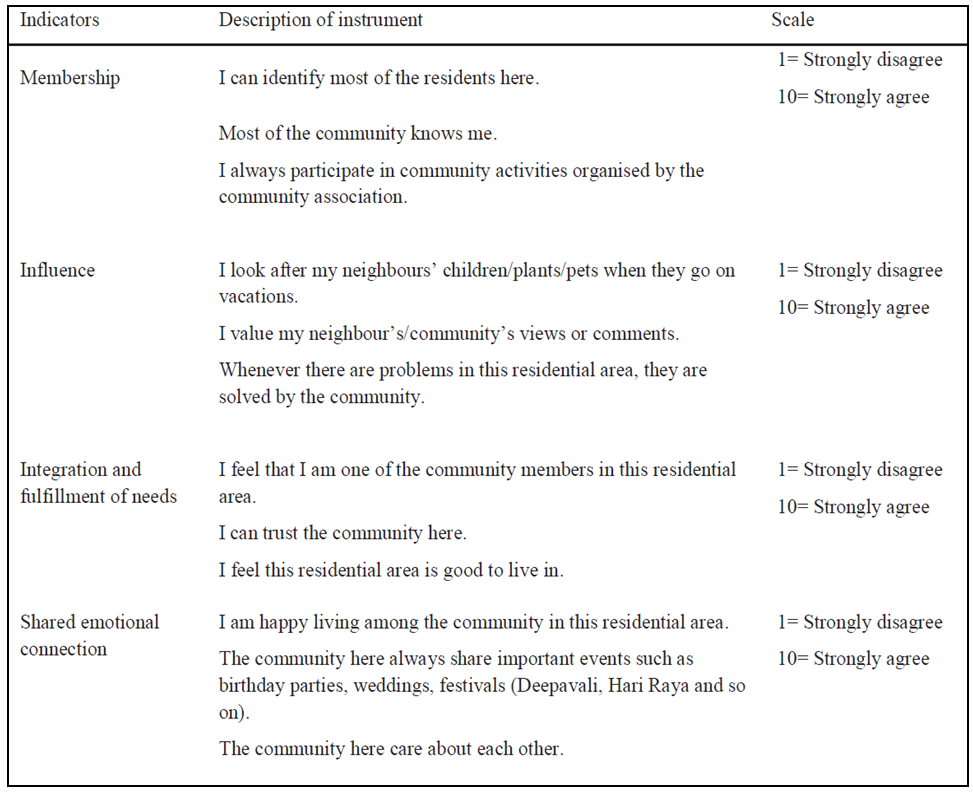 | Figure 7. Sense of Community Indicators |
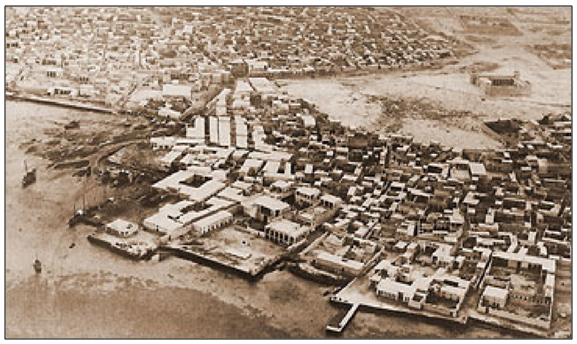 | Figure 8. Gated communities on the sea front of Doha back in 1950 (Lockerbie, 2005) |
3. The Research Design
- To facilitate the collection of detailed data, qualitative interviews were conducted in order to evaluate the experience of residents living in gated communities (Zeisel 1975; Zeisel 1984; Creswell 1994; Denzin and Lincoln 2005; Dunn 2005; Charmaz 2006; Marshall and Rossman 2010). The quantitative approach of surveys would not have contributed towards a deep understanding of the residents’ living experience. Moreover, for this research study, the qualitative approaches are more sensitive to capture the insights from people experiences (Minichiello, Browne et al. 2000). In-depth interviews, focused or semi-structured, enabled the researcher to explore, access and understand the events and activities that might not be directly observed by the researcher (Minichiello, Browne et al. 2000). In this research study, the method adopted by Satha Low, an American anthropologist, was followed. In her study, she documented the existence of the urban fear by studying gated communities in America and Mexico. As part of her research, she interviewed residents of gated communities in San Antonio, Texas (Low 2001). The Selected Case Study: Al-Ein CompoundThis research study aims to investigate the sense of community in Gated Communities in Doha, Qatar. It explores the perception of gated communities by the residents and whether these communities have satisfied residents’ social needs. For this research study, Al-Ein compound in Ein Khaled neighborhood is selected as the case study, being Ein Khaled a neighborhood containing a high number of residential compounds in Doha. The compound was constructed in 2012 for employees of Hamad Medical Care. However, it is now open to the public - only 20% of the buildings are leased to Hamad Medical Care staff. The demographic of the residents of Al-Ein compound varies in terms of nationalities, religions and family size. The compound has one main controlled entrance with security guards and cameras. It is surrounded by walls from all sides. The access to the development is controlled and limited to residents and visitors only. Al-Ein gated community contains 110 attached villas on thirty seven thousand square meters. It includes numbers of amenities that serves its residents and provide them with the basic needs, reducing users’ everyday travels outside the gated community. The available amenities in Al-Ein compound enclose a mosque, kindergarten, laundry, supermarket and a clubhouse that contains a multi-purpose hall, male and female gym and a cafe. The outdoor amenities include children playground and two swimming pools, one for kids and one for adults (figure 3-4-5-6). Interviews with Gated Community ResidentsA total of twenty interviews were held with residents of Al-Ein compound. To ensure the privacy of the residents, all interviewees’ names have been coded. The interviews were structured with open ended questions investigating four main itopics, central to the research question: (A) the motivation behind moving to gated community, (B) the living experience in the gated community, (C) the relationship with other residents and (D) the measuring of the sense of community. The interviews, scheduled to elicit the maximum range of response, were structured into three parts: (A) opening or beginning, (B) topical section or middle, (C) closing or open-ending. The interviewees residing in the compound were interviewed along November 2016’s four weekends, in the park of the gated community, in order to avoid distress and discomfort for the residents. In total, twenty respondents participated: 75% of which were females, 15% males and 10% children. In terms of ethnicity, the dominant respondents were Muslims non-Qatari Arabs. 90% of adult respondents were married. In addition, visual material such as maps and photographs, collected though site visits and observation, were reviewed to obtain secondary data.
4. Findings
- The Motivation behind Moving to Gated CommunityThe findings reveal that interviewees residing within the compound are not basically attracted to gated communities just for security reasons. Rather, they are motivated to move to gated communities because of the so-called “package”, consisting of number of facilities, location and the bundle of benefits, which includes security. Interviewees stated that living in gated development had diverse benefits, such as sense of community and belonging, better designed urban amenities, enhanced feelings of safety and security.Although, the majority of the respondents consider Doha as a safe city with low rates of crime, they appreciate the security provided within gated communities. Also, the security feeling is related to the increased road safety because of the reduced traffic, and thus the suitability of such communities for children not needing constant adults’ supervision. The Living Experience in the Gated CommunityThe living experience in gated communities is described by residents as a resort-style living. Residents have access to many facilities, to which they could not afford otherwise, such as a swimming pool and/or a tennis court. Such facilities are shared and free-access within the compound. The availability of different facilities in gated communities contributes to enhance quality of life and well-being of residents. Residents highlighted that daily activities performed with their neighbors, such as gathering in front of their houses, breaks the routine of their day and help them to relax. Moreover, the provision of constant maintenance to the buildings facilitates an easier lifestyle as residents do not have to think about it. In addition, the availability of children activity areas adds to the livability level of the gated community. Most interviewed residents stated that they moved to gated community because of the safe and relaxing entertainment areas dedicated to children within the compound. The Relationship with Other Residents The relationships among the residents of the community is one of the determiners of housing satisfaction as strong social relations can reduce the desire to move and enhances the sense of belonging. 80% of the respondents stress the relatively strong relationships with their neighbors and some of them consider their neighbors as close friends. A few respondents state that it would be difficult for them to move from the gated community cause of the acquired friendships, which contribute to enhance a sense of security within the compound. The good relations among the residents also enhance the corporation: residents try to help and support each other whenever needed. Moreover, the relationships that are established in gated communities improve the residents’ health, especially for female residents. 66.6% of the female respondents stated that that they started exercising regularly since they have moved to gated community. Similar results were found among children participants who elaborated that they have strong friendship with their neighbors as they play, exercise and study together (figure 9-10).
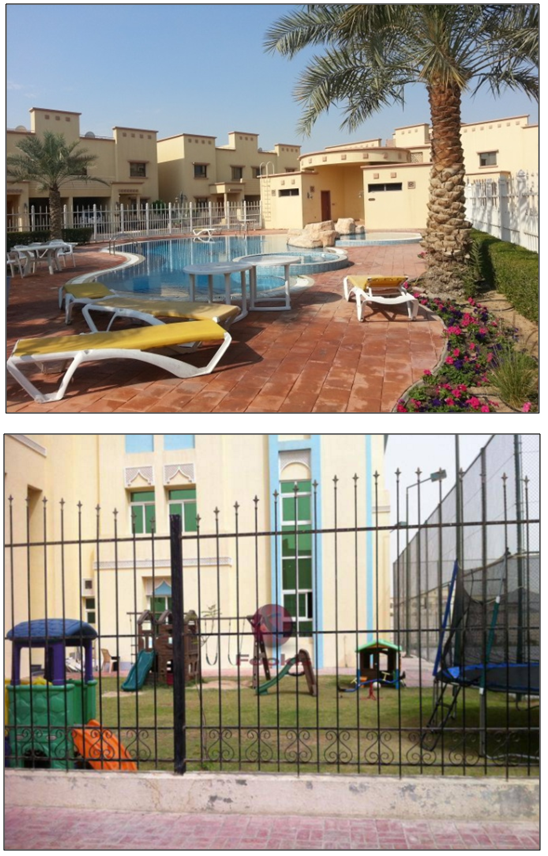 | Figure 9/10. The Social Gathering Area-Children playground and the Swimming Pool Source: author |
5. Conclusions
- Qatar has witnessed during the last 20 years a rapid development (Furlan, Eissa et al. 2015; Furlan and Faggion 2015; Furlan and Faggion 2015; Furlan 2016; Furlan 2016). The increasing percentage of expats in Doha has led to a diverse and fragmented demography in the city (Salama and Wiedman 2013). Therefore, gated communities have become popular dominant housing form in Qatar (Furlan and Petruccioli 2016). There are more than 120 gated communities according to census 2012 (Qatar Map, 2012) and this number is continuously growing. Thus, it is important to study this type of housing form in Qatar (A) to explore the extent to which gated communities’ residents experience “Sense of Community” and (B) to define strategies for the implementation of the physical settings in order to match the needs of residents.Also, the findings reveal that neighborhoods should be designed to provide and offer the benefits of the gated communities in terms of security and well-designed amenities and public realm, which can encourage the social interactions among resident and, therefore, improve the sense of community in the whole neighborhood.
6. Implications for Practice and Advancement of Research
- This section discusses the findings revealed from this research study and explores their broader implications for planning of residential compounds. Gated communities satisfy, in part, residents’ needs for leisure facilities and for well-designed living environments. However, addressing the concerns of contemporary society’s challenges, designers and urban planners can play an effective role in designing urban districts and/or communities, spaces and places which could encourage social interactions and cohesion among residents. This research study indicates that there is a crucial need for planners and designers to provide proper alternatives to the current gated community residential settings. These alternatives should provide the residents’ need of desirable local amenities, security, adequate traffic management and opportunities for social interaction (Grant, Greene et al. 2004). Through well-designed neighborhoods that contains all mentioned aspects, planners and designers would contribute to improving the sense of community and encouraging social interactions. Therefore, this could improve well-being of the wide community. Urban Planners and policy makers should emphasize and focus their attention on the provision of public facilities, infrastructure and services, which could contribute to improving the public realm of neighbourhoods. Further research is auspicated to investigate the distribution of gated communities in Qatar and to explore the extent to which such communities should be linked to the neighborhood, namely focusing on aspects such as cultural values and/or differences, ethnicity and religious belief.
ACKNOWLEDGEMENTS
- The authors would like to acknowledge the support of Qatar University for creating an environment that encourages scientific research. This research study was developed as an assignment at the core-course ‘Urban Design in Practice’ (MUPD-711, Fall-2016) for the Master in Urban Planning and Design Program (MUPD) and ‘Adv. Spec. Top. I in Urban Planning’ (PHUP751, Fall-2016) for the PhD program at Qatar University, College of Engineering, Department of Architecture and Urban Planning (DAUP), taught by Raffaello Furlan. The authors would like to express their gratitude to the leading planners and architects from the Ministry of Municipality and Urban Planning (MMUP), Ashghal-Public Works Authority for their collaboration, for participating in the meetings, handling relevant visual data and cardinal documents to the research aims and finally to discuss the conclusive results of this investigation. Finally, the authors thank the anonymous reviewers for their comments, which contributed to an improvement of this paper. The authors are solely responsible for the statements made herein.
 Abstract
Abstract Reference
Reference Full-Text PDF
Full-Text PDF Full-text HTML
Full-text HTML